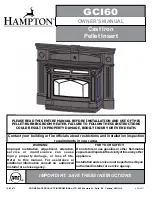
2.9
APPLIANCE EXEMPTION UNDER SECTION 21 OF THE CLEAN AIR ACT
1993 AND SMOKE CONTROL AREAS (CONTINUED).
2.9.4
Refuelling on to a low fire bed
If there is insufficient burning material in the fire bed to light a new fuel charge,
excessive smoke emission can occur. Refuelling must be carried out onto a
sufficient quantity of glowing embers and ash that the new fuel charge will ignite.
If the fire bed is too low or cool, suitable kindling must be used to re-light fires.
2.9.5
Fuel overloading
The maximum amount of fuel specified in this manual must not be exceeded,
overloading can cause excessive smoke.
2.9.6
Operation with door left open
Operation with the door left open can cause excessive smoke. The appliance
must not be operated with the door left open except as directed in the
instructions.
2.9.7
Dampers left open
Operation with the air controls or dampers can cause excessive smoke. The
appliance must not be operated with the air controls or dampers left open except
as directed in the instructions.
2.10
REQUIREMENTS TO FIT A CARBON MONOXIDE (CO) ALARM
2.10.1
When this stove is installed, Building Regulations require that whenever a new or
replacement fixed solid fuel or wood/biomass appliance is installed in a dwelling a
carbon monoxide alarm must be fitted in the same room as the appliance.
Further guidance on the installation of the Carbon Monoxide alarm is available in
the latest version of BS EN 50292 and from the alarm manufacturers instructions.
2.10.2
IMPORTANT NOTE : The installation a Carbon Monoxide (CO) alarm is not a
substitute for installing the appliance correctly, regular servicing and maintenance
of the chimney / flue or the stove itself. Please ensure that regular servicing in
accordance with section 7.6 of this manual is completed.
2.10.3
WARNING NOTE : Properly installed, operated and maintained this stove stove will
not emit fumes into the dwelling. Occasional fumes from de-ashing and
re-fuelling may occur. However, persistent fume emission is potentially dangerous
and must not be tolerated. If fume emission does persist the following action
must be taken:-
Open windows and door to ventilate the room and then leave the premises.
Let the fire go out.
Check for chimney blockage and clean if required.
Do not attempt to re-light the fire until the cause of fume emission has been
identified and corrected. If necessary seek expert advice.
The most common cause of fume emission is flueway or chimney blockage. For
your own safety these must be kept clear at all time.
Page 7 of 18




































